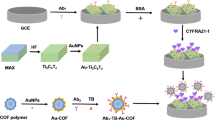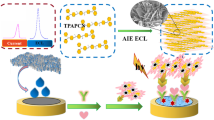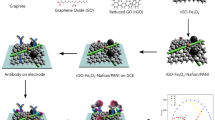Abstract
Improving the sensitivity of detection is crucial to monitor biomarker, assess toxicity, and track therapeutic agent. Herein, a sensitivity-improved immunosensor is reported for the first time via functionalized graphene oxide (GO) and a “grafting-to” ring-opening polymerization (ROP) dual signal amplification strategy. Through the ROP reaction using 2-[(4-ferrocenylbutoxy)methyl] oxirane (FcEpo) as the monomer, lots of electroactive tags are linked in situ from multiple initiation sites on the GO surface modified with ethanol amine (GO-ETA), thereby achieving high sensitivity even in the case of trace amounts of tumor markers. The utmost important factor for achieving this high sensitivity is to select functionalized GO as the initiator that contains a large number of repeated hydroxyl functional groups so as to trigger additional ROP reaction. Under the optimal conditions, the high sensitivity and applicability is demonstrated by the use of GO-ETA-mediated ROP-based immunosensor to detect non-small cell lung cancer (NSCLC)–specific biomarker down to 72.58 ag/mL (equivalent to ~6 molecules in a 5 μL sample). Furthermore, the satisfactory results for the determination of biomarkers in clinical serum samples highlighted that this immunosensor holds a huge potential in practical clinical application.
Graphical abstract

This work described an electrochemical immunosensor for ultrasensitive detection of CYFRA 21-1 via the functionalized graphene oxide (GO) and a “grafting-to” ring-opening polymerization (ROP) dual signal amplification strategy, which hold the merits of high sensitivity, applicability, selectivity, efficiency, easy operation and environmental friendliness.






Similar content being viewed by others
References
Alexander V, Andrej B, Milos M, Abdel HH, Saleh A, Jan K (2019) The involvement of the phosphorylatable and nonphosphorylatable transcription factor CREB-1 in the control of human ovarian cell functions. Comptes Rendus Biologies 342:90–96
Sun T, Zhang Y, Zhao F, Xia N, Liu L (2020) Self-assembled biotin-phenylalanine nanoparticles for the signal amplification of surface plasmon resonance biosensors. Microchim Acta 187:8
Qin D, Jiang X, Mo G, Zheng X, Deng B (2020) Electrochemiluminescence immunoassay of human chorionic gonadotropin using silver carbon quantum dots and functionalized polymer nanospheres. Microchim Acta 187:8
Halvorsen EH, Pollmann S, Gilboe IM, van der Heijde D, Landewé R, Ødegard S, Kvien TK, Molberg Ø (2008) Serum IgG antibodies to peptidylarginine deiminase 4 in rheumatoid arthritis and associations with disease severity. Ann Rheum Dis 67:414–417
Jeon S, Moon JM, Lee ES, Kim YH, Cho Y (2014) An electroactive biotin-doped polypyrrole substrate that immobilizes and releases EpCAM-positive cancer cells. Angew Chem Int Ed Eng 53:4597–4602
Zhao YD, Bertolazzi S, Maglione MS, Rovira C, Mas-Torrent M, Samorì P (2020) Molecular approach to electrochemically switchable monolayer MoS2 transistors. Adv Mater Weinheim 32:e2000740
Zhang LL, Abdullah R, Hu XX, Bai HR, Fan HH, He L, LiangH ZJM, Liu YL, Sun Y, Zhang XB, Tan WH (2014) Engineering of bioinspired, size-controllable, self-degradable cancer-targeting DNA nanoflowers via the incorporation of an artificial sandwich base. J Am Chem Soc 141:4282–4290
Albada B, Metzler-Nolte N (2017) Highly potent antibacterial organometallic peptide conjugates. Acc Chem Res 50:2510–2518
Bao HM, Zhang HW, Zhang P, Fu H, Zhou L, Li Y, Cai WP (2020) Conduct ometric response-triggered surface-enhanced Raman spectroscopy for accurate gas recognition and monitoring based on oxide-wrapped metal nanoparticles. ACS Sensors 5:1641–1649
Fu LH, Hu YR, Qi C, He T, Jiang SS, Jiang C, He J, Qu JL, Lin J, Huang P (2019) Biodegradable manganese-doped calcium phosphate nanotheranostics for traceable cascade reaction-enhanced anti-tumor therapy. ACS Nano 13:13985–13994
Tanwar AS, Adil LR, Afroz MA, Iyer PK (2018) Inner filter effect and resonance energy transfer based attogram level detection of nitroexplosive-picric acid using dual emitting cationic conjugated polyfluorene. ACS Sensors 3:1451–1461
Zhang KH, Zhang MM, Feng XL, Hempenius MA, Vancso GJ (2017) Smart windows: switching light transmittance by responsive organometallic poly(ionic liquid)s: control by cross talk of thermal and redox stimuli. Adv Funct Mater 27:17027841–170278488
Hudson ZM, Manners I (2014) Assembly and disassembly of ferrocene-based nanotubes. Science 344:481–482
Fujimura K, Ouchi M, Sawamoto M (2019) Ferrocene cocatalysis for iron-catalyzed living radical polymerization: active, robust, and sustainable system under concerted catalysis by two iron complexes. Polym Chem 6:7821–7826
Braendlein M, Pappa AM, Ferro M, Lopresti A, Acquaviva C, Mamessier E, Malliaras GG, Owens RM (2017) Lactate detection in tumor cell cultures using organic transistor circuits. Adv Mater Weinheim 29:16057441–16057446
Wang H, Sun YB, Chen QW, Yu YF, Cheng K (2010) Synthesis of carbon-encapsulated super paramagnetic colloidal nanoparticles with magnetic-responsive photonic crystal property. Dalton Trans 39:9565–9569
Teimuri-Mofrad R, Abbasi H, Hadi R (2019) Graphene oxide-grafted ferrocene moiety via ring opening polymerization (ROP) as a supercapacitor electrode material. Polymer 109:1971–1078
Kamber NE, Jeong W, Waymouth RM, Pratt RC, Lohmeijer BG, Hedrick JL (2007) Organocatalytic ring-opening polymerization. Chem Rev 107:5813–5840
Zhang X, Fan X, Li H, Yan C (2012) Facile preparation route for graphene oxide reinforced polyamide 6 composites via in situ anionic ring-opening polymerization. J Mater Chem 22:24081–24091
Wurtz CA (2019) Lecons de Philosophie Chimique. Ann Chim Phys 69:317–354
Gilroy JB, Patra SK, Mitchels JM, Winnik MA, Manners I (2011) Main-chain heterobimetallic block copolymers: synthesis and self-assembly of polyferrocenylsilane-b-poly(cobaltoceniumethylene). Agnew Chem Int Ed 50:5851–5855
Gibbs JM, Park SJ, Anderson DR, Watson KJ, Mirkin CA, Nguyen ST (2005) Polymer DNA hybrids as electrochemical probes for the detection of DNA. J Am Chem Soc 127:1170–1178
Hu Q, Wang QW, Kong JM, Li LZ, Zhang XJ (2018) Electrochemically mediated in situ growth of electroactive polymers for highly sensitive detection of double-stranded DNA without sequence preference. Biosens Bioelectron 101:1–6
Hu Q, Wang QW, Jiang CH, Zhang J, Kong JM, Zhan XJ (2018) Electrochemically mediated polymerization for highly sensitive detection of protein kinase activity. Biosens Bioelectron 110:52–57
Zhang JY, Liu QR, Ba YY, Cheng JM, Yang HX, Cui Y, Kong JM, Zhang XJ (2019) Anal Chim Acta 1094:99–105
Zhao LY, Yang HX, Zheng XK, Li JG, Jian LH, Feng WS, Kong JM (2020) Dual signal amplification by polysaccharide and eATRP for ultrasensitive detection of CYFRA 21–1 DNA. Biosens Bioelectron 150:111895
Wu YF, Wei W, Liu SQ (2012) Target-triggered polymerization for biosensing. Acc Chem Res 45:1441–1450
Bai GY, Gao D, Liu Z, Zhou X, Wang JJ (2019) Probing the critical nucleus size for ice formation with graphene oxide nanosheets. Nature 576:437–441
Yang GJ, Xiao ZQ, Tang CL, Deng Y, Huang H, He ZY (2019) Recent advances in biosensor for detection of lung cancer biomarkers. Biosens Bioelectron 141:111416
Yu YY, Huang ZN, Zhou Y, Zhang LH, Liu AL, Chen W, Lin JH, Peng HP (2019) Facile and highly sensitive photoelectrochemical biosensing platform based on hierarchical architectured polydopamine/tungsten oxide nanocomposite film. Biosens Bioelectron 126:1–6
Wang T, Zhang Z, Li Y (2015) Amplified electrochemical detection of MecA gene in methicillin-resistant staphylococcus Aureus based on target recycling amplification and isothermal strand-displacement polymerization reaction. Sensors Actuators B Chem 221:148–154
Funding
This work was supported by the project of tackling of key scientific and technical problems in Henan Province (192102310033), National Natural Science Foundation of China (21974068), and the project of tackling of key scientific and technical problems in Henan Province (202102310149).
Author information
Authors and Affiliations
Corresponding authors
Ethics declarations
The clinical serum samples were obtained from The Third Affiliated Hospital of Henan University of Chinese Medicine. The Ethics Committee of Henan Province Hospital of Traditional Chinese Medicine approved the exploitation of serum samples for research purpose, and ten volunteers provided written informed consent before collecting serum samples.
Conflict of interest
The authors declare no competing of interests.
Additional information
Publisher’s note
Springer Nature remains neutral with regard to jurisdictional claims in published maps and institutional affiliations.
Supplementary information
ESM 1
(DOCX 593 kb)
Rights and permissions
About this article
Cite this article
Liu, Y., Hao, L., Wang, W. et al. Functionalized graphene oxide in situ initiated ring-opening polymerization for highly sensitive sensing of cytokeratin-19 fragment. Microchim Acta 188, 123 (2021). https://doi.org/10.1007/s00604-021-04780-7
Received:
Accepted:
Published:
DOI: https://doi.org/10.1007/s00604-021-04780-7




